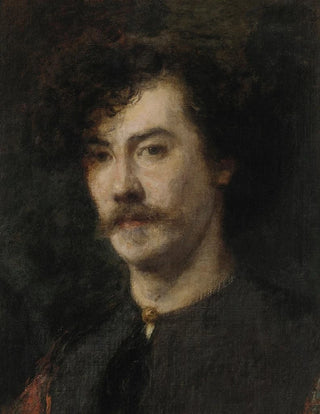Art print | Portrait of Whistler - Henri Fantin-Latour


View from behind

Frame (optional)
Portrait of Whistler - Henri Fantin-Latour – Captivating Introduction
In the art world, some works transcend the mere frame to become living testimonies of an era, a meeting, or an emotion. The "Portrait of Whistler" by Henri Fantin-Latour is one of those creations that capture not only the appearance of their subject but also the very essence of the relationship between the artist and their model. Created in 1867, this painting is an ode to the friendship between two emblematic figures of the 19th-century artistic movement. Through this work, Fantin-Latour does not just paint James Whistler, but immortalizes a unique moment in art history, an instant where painting becomes the reflection of an intellectual and artistic complicity.
Style and uniqueness of the work
The "Portrait of Whistler" stands out for its intimate approach and delicate palette. Fantin-Latour, known for his still lifes and portraits, uses soft lighting that envelops Whistler's face, emphasizing the fine features and the contemplative expression of his friend. The composition is carefully balanced, with a dark background that highlights the brightness of the face, creating a striking contrast. The artist chooses to position his subject slightly in profile, which adds depth to the representation while allowing the viewer to appreciate the meticulous details of Whistler's attire. This stylistic choice reflects not only Fantin-Latour's technical mastery but also his desire to pay homage to the individuality of his model. The work, both sober and emotionally rich, invites silent contemplation, where each gaze reveals a new facet of this artistic friendship.
The artist and his influence
Henri Fantin-Latour, although less famous than some of his contemporaries, played a crucial role in the development of modern art. His ability to capture the human soul through portraiture influenced many artists, both in his time and beyond. Fantin-Latour is often associated with the Impressionist movement, even though he maintained a more academic and classical approach in his work. His friendship with Whistler, as well as with other artists like Édouard Manet and Claude Monet, nourished his artistic vision and his commitment to the

Matte finish

View from behind

Frame (optional)
Portrait of Whistler - Henri Fantin-Latour – Captivating Introduction
In the art world, some works transcend the mere frame to become living testimonies of an era, a meeting, or an emotion. The "Portrait of Whistler" by Henri Fantin-Latour is one of those creations that capture not only the appearance of their subject but also the very essence of the relationship between the artist and their model. Created in 1867, this painting is an ode to the friendship between two emblematic figures of the 19th-century artistic movement. Through this work, Fantin-Latour does not just paint James Whistler, but immortalizes a unique moment in art history, an instant where painting becomes the reflection of an intellectual and artistic complicity.
Style and uniqueness of the work
The "Portrait of Whistler" stands out for its intimate approach and delicate palette. Fantin-Latour, known for his still lifes and portraits, uses soft lighting that envelops Whistler's face, emphasizing the fine features and the contemplative expression of his friend. The composition is carefully balanced, with a dark background that highlights the brightness of the face, creating a striking contrast. The artist chooses to position his subject slightly in profile, which adds depth to the representation while allowing the viewer to appreciate the meticulous details of Whistler's attire. This stylistic choice reflects not only Fantin-Latour's technical mastery but also his desire to pay homage to the individuality of his model. The work, both sober and emotionally rich, invites silent contemplation, where each gaze reveals a new facet of this artistic friendship.
The artist and his influence
Henri Fantin-Latour, although less famous than some of his contemporaries, played a crucial role in the development of modern art. His ability to capture the human soul through portraiture influenced many artists, both in his time and beyond. Fantin-Latour is often associated with the Impressionist movement, even though he maintained a more academic and classical approach in his work. His friendship with Whistler, as well as with other artists like Édouard Manet and Claude Monet, nourished his artistic vision and his commitment to the






